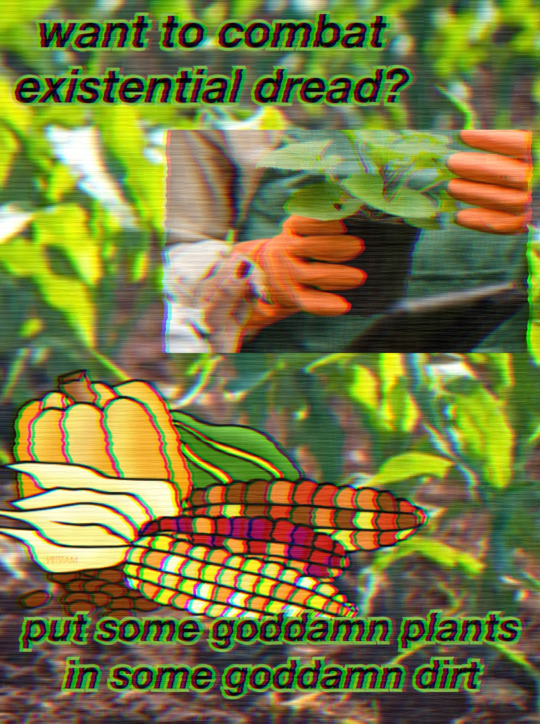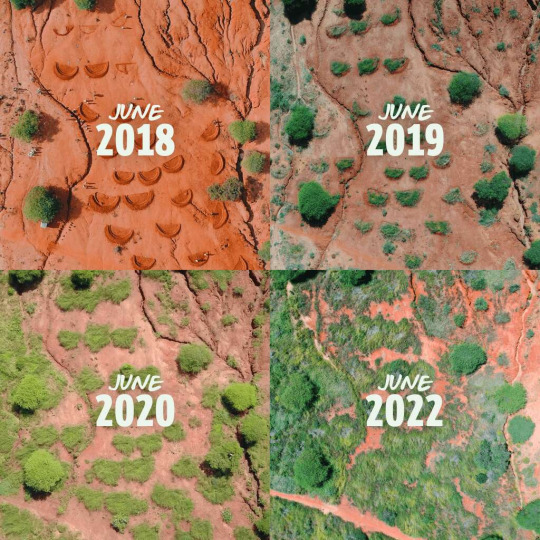#Permaculture
Explore tagged Tumblr posts
Text

8K notes
·
View notes
Text





putting things by...
362 notes
·
View notes
Text
"The slogan 'refuse, reduce, reuse, repair and recycle' provides us with a hierarchy of strategies for dealing with waste. Refuse means to decide not to engage in the consuming action or task in the first place because it is not necessary. Reduce means to minimize the materials and energy required or the frequency of the consuming action. Reuse means either reuse for the same purpose or put to the next best use. Repair means to use skill and very limited additional resources to restore function. Recycle means to break down into more basic elements or materials before being reprocessed for the same or other uses."
- Permaculture: Principles & Pathways Beyond Sustainability by David Holgren, page 112
#permaculture#refuse reduce reuse repair recycle#waste#environmental#sustainability#environment#waste reduction
2K notes
·
View notes
Text
If sharks and wolves and mushrooms and snakes and deserts and bugs are not thriving in your utopian solarpunk future, you don't want to protect ecosystems you want to protect things you find pretty.
#solarpunk#environment#environmentalism#permaculture#pollution#climate change#leftism#leftist#utopia
698 notes
·
View notes
Text


🌱✨️ "Living Soil" Embroidered Crewnecks & Hoodies ✨️🌱
Stay cozy while supporting soil health and sustainable farming 💚💛❤️
🌟 when you sign up for email offers and updates on our website, you get a chance to win up to 50% OFF your order!
🌟 FREE SHIPPING for orders over $50!!!
#soil health#soil science#soil#permaculture#environmental education#enviroment art#regenerative agriculture#regenerative farming#agriculture#sustainable living#sustainable farming#sustainability#organic life#organic matter#organic lifestyle#organic farming#organic#compost lifestyle#composting#compost#vermicompost#biodiversity#ecomindset#conservation#microbes#plant life#plant lover#street style#hippie#stoner society
565 notes
·
View notes
Text
With Hurricane Milton barreling towards Florida, I am honestly expecting the further normalization of extreme climate events. Especially because the destruction caused by Hurricane Helene just happened.
Somehow, people are still debating on whether climate change actually exists, while people are having their homes and livelihoods completely decimated.
We cannot continue like this and keep waiting for things to get worse and impact us personally. Watching others suffer should be enough for us to finally decide to take action.
Taking action against climate change is not only just protesting, but learning about the environment and gardening. Plant native species and help protect areas local to you. Join cleanup efforts and advocate for local green energy initiatives.
#hurricane helene#hurricane milton#climate change#global warming#environment#permaculture#solarpunk#green energy#native plants#us politics
808 notes
·
View notes
Text
"A recent World Meteorological Organization report called heat waves the “deadliest meteorological hazard” from 2015 to 2019, affecting people living on all continents, and setting new national heat records in many regions.
Canada’s top weather event in 2021 was British Columbia’s record-breaking heat, according to Environment and Climate Change Canada. The temperature in Lytton, B.C., hit 49.6 C on June 29. The following day a wildfire destroyed 90 per cent of the town, killing two people and displacing 1,200 others.
Heat waves also exacerbate existing health issues, including cardiovascular and respiratory disease. They’re associated with increased hospital admissions, psychological stress and aggressive behavior, as well as excess mortality.
During heat waves, the highest temperatures are often found in urbanized areas. Urbanization is almost always associated with an increase in paved, impervious areas, and often a decrease in greenery. Concrete and asphalt roads, and other built materials readily absorb, store and release heat, raising city temperatures, a phenomenon called the urban heat island.
Many studies have shown that urban forests can reduce the urban heat island, and many policies focus their attention on large green spaces.
Small green spaces, such as yards, rooftops and small parcels of undeveloped land, can make impressive contributions to lowering urban heat, but they are often overlooked when developing strategies for urban cooling.
The effect of small green spaces
Cities rarely have the opportunity to add large green spaces to help counter the effects of heatwaves. Smaller vegetated spaces, however, can still meaningfully decrease local land temperatures.
Small green spaces, such as yards, rooftops and small parcels of undeveloped land, can make impressive contributions to lowering urban heat, but they are often overlooked when developing strategies for urban cooling.
A recent study in Adelaide, Australia, found that tree canopy cover and, to a lesser extent, grass cover decreased local daytime surface temperatures by up to 6 C during extreme summer heat conditions. Further inland, suburban yards and gardens can decrease local surface temperatures up to 5 C.
At a quite small scale, on the order of tens of square metres, trees reduced daytime surface temperatures twice as much as grass cover. But grass and other small, low-lying plants, grow relatively quickly, compared to trees.
Cities should adopt short-term and long-term strategies to respond to extreme heat, including the replacement of paved and impervious surfaces with grasses and turf, and increasing tree plantings to boost canopy coverage.
Amplifying the cooling effect
Furthermore, when managing small green spaces, city planners and foresters can select tree species based on their ability to cool the environment. Green spaces with a high diversity of tree species have a greater cooling effect in spring, summer and fall. They also have a larger maximum drop in temperature in the summer, compared to spaces that are less diverse.
For example, tree canopies with large leaves and high transpiration rates — the evaporation of water from plants occurring at the leaves — could provide more cooling.
Planting a variety of species, of different heights, can have a larger cooling effect than tall trees alone.
The structure of green space may also influence its cooling efficiency. In summer, a plant community with multiple layers of trees, shrubs and herbs can further decrease air temperature by 1 C on a sunny day and 0.5 C on a cloudy day, compared with an area only dominated by tall trees...
But overall, trees usually have a stronger effect on cooling than grass. Planting trees in groups, not individually or in lines, is recommended for regulating the microclimate (local climate conditions near the Earth’s surface).
Small green spaces can offer a lot of summer cooling in cities. And cities can learn to manage the configuration of small green spaces better to get more cooling benefits and minimize the trade-offs."
-via GoodGoodGood, July 4, 2024
#green space#urban#urban landscape#urban forest#urban green spaces#food forest#permaculture#gardening#microclimate#cooling#conversation#global warming#climate change#climate action#solarpunk#rooftop garden#ecopunk#meterology#ecology#ecosystems#environmental science#plant trees#good news#hope
766 notes
·
View notes
Text
Surviving and Thriving in Collapse: A Good Library and Reskilling

March 25 2025, Dana O'Driscoll, AODA
Excerpt:
In my first post in this series, I talked about the global collapse that is happening and what to do about it–and as hard as it is, the reasons to keep up the hope and the vision for a better future and paradigm. As I shared in my first post, what we need to do now, as things are collapsing, is to lean into and create the world we want to create. But how to do we actually get there? One step at a time, my friends. In my first post, I outlined the situation as I see it and then shared some resources to help orient our minds and mentally prepare and cultivate mental resilience. This post assumes that you’ve read the first post, and also, that you are feeling like you are in a place to take a few more steps. And so today’s topic is: building a good library!
Read the full post on The Druid's Garden.
Dana O'Driscoll is the Grand Archdruid of the Ancient Order of Druids in America and the co-found of the Pennsylvania School for Herbalism. She is also a Certified Permaculture Designer and Teacher, and the creator of the Tree Lore and Plant Spirit oracle decks. She has published two books on connecting modern pagan practices with permaculture, sustainable living, and responsible land stewardship. Sacred Actions and Land Healing are both available from Schiffer Books.
#Dana is also just a fabulous human being and I highly recommend her work to anyone interested in druidry or green magic or permaculture.#witchcraft#permaculture#sustainable living#pagan#druidry#gardening#libraries
343 notes
·
View notes
Text
516 notes
·
View notes
Text
ok so instead of going on my usual the earth is doomed spiral I started looking into solar punk solutions and stumbled across the practice of permaculture & found a free 50 video series from the university of oregon on it if anyone else would like to learn abt ways we can actually start restoring earths whole deal
4K notes
·
View notes
Text

A photo of my wonderful little garden, and some of the things which have been harvested from it recently.







151 notes
·
View notes
Text
RPTU University of Kaiserslautern-Landau has shown for the first time, in a joint study with BOKU University, that permaculture brings about a significant improvement in biodiversity, soil quality and carbon storage. In view of the challenges of climate change and species extinction, this type of agriculture proved to be a real alternative to conventional cultivation—and reconcile environmental protection and high yields. Permaculture uses natural cycles and ecosystems as blueprint. Food is produced in an agricultural ecosystem that is as self-regulating, natural and diverse as possible. For example, livestock farming is integrated into the cultivation of crops or the diversity of beneficial organisms is promoted in order to avoid the use of mineral fertilizers or pesticides. In a study, published in the journal Communications Earth & Environment, researchers from RPTU and BOKU have now, for the first time, comprehensively investigated the effects of this planning and management concept on the environment.
[...]
"Permaculture appears to be a much more ecologically sustainable alternative to industrial agriculture," said Julius Reiff . At the same time, the yields from permaculture are comparable to those of industrial agriculture, as the researchers' not yet published data shows. "In view of the challenges of climate change and biodiversity loss, the observed improvements would represent a real turnaround when applied to larger areas," says ecosystem analysis expert Martin Entling from RPTU.
4 July 2024
458 notes
·
View notes
Text
Making Desert Land Fertile with Water Bunds

#permaculture#regenerative ag#regenerative agriculture#agriculture#farming#gardening#how to make soil more fertile#how to turn a desert into fertile land#soil#soil fertility#organic farming#organic gardening#water harvesting
3K notes
·
View notes
Text
indoor gardening starter guide
Hello internet people!! I have finished my first starter guide ! This guide has info on indoor gardening. My focus was mainly budget friendly and space friendly approach. I decided to cut out a fair bit of information for this first one that will go on future guides, so if it feels limited, let me know what you'd like me to expand on first, and ill get working on those first!!
I also plan to offer formal printed versions w an art print on my etsy, just so that if people want to say thanks with a donation they can!
But I want the information to be accessible no matter what, so this online copy will be up and available regardless of what paid options I make! PLEASE print a copy yourself!! print media is so valuable, and online hosting sites change their policy all the time.
PLEASE copy and distribute !!
#solarpunk#cottagecore#gardening#urban gardening#urban homesteading#my posts#sustainability#permaculture#physical media#media preservation#container gardening#gardenblr#home garden
204 notes
·
View notes
Text

Built a greenhouse out of reclaimed windows and scrap wood, took me an embaresing amount of time but it looks good now.
1K notes
·
View notes